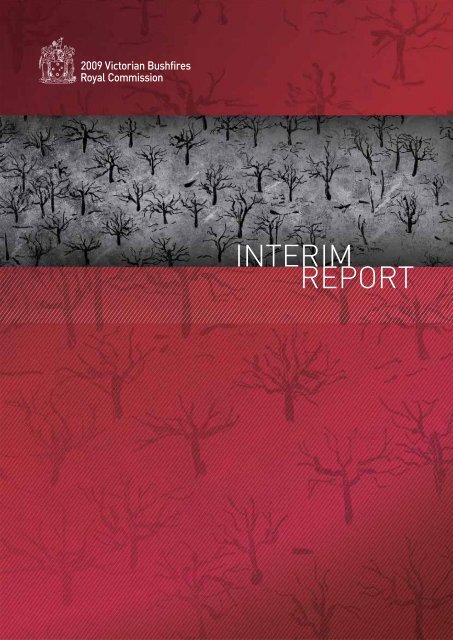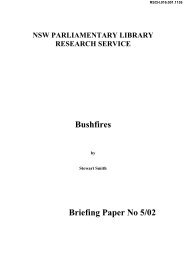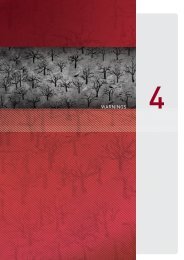Introductory pages - 2009 Victorian Bushfires Royal Commission
Introductory pages - 2009 Victorian Bushfires Royal Commission
Introductory pages - 2009 Victorian Bushfires Royal Commission
Create successful ePaper yourself
Turn your PDF publications into a flip-book with our unique Google optimized e-Paper software.
INTERIM<br />
REPORT
The painting on the front cover, Mountain Ash, is by Kinglake artist Linda Haggar.<br />
When the inferno swept through Kinglake on Black Saturday, Linda was at home<br />
with her husband Wayne. Her eldest daughter Kristin and husband, Heath, and<br />
their two children, 14-year old Shelby and 12-year old Oscar, were also with Linda.<br />
While the adults successfully fought the blaze, Linda’s grandchildren comforted<br />
the family’s two pet dogs and a cat. All survived.<br />
Linda was inspired to paint Mountain Ash when she flew over her property<br />
in a helicopter and viewed the devastated landscape below.<br />
The <strong>Commission</strong> thanks Linda Haggar for making Mountain Ash available<br />
for reproduction throughout this report.<br />
ISBN 978-0-646-51830-5<br />
Published August <strong>2009</strong>
<strong>2009</strong> VICTORIAN BUSHFIRES ROYAL COMMISSION<br />
INTERIM REPORT<br />
THE HON BERNARD TEAGUE AO – CHAIRPERSON<br />
RONALD MCLEOD AM – COMMISSIONER<br />
SUSAN PASCOE AM – COMMISSIONER<br />
ORDERED TO BE PRINTED<br />
August <strong>2009</strong><br />
By Authority<br />
Government Printer for the State of Victoria<br />
No. 225 – Session 2006–09<br />
I
<strong>2009</strong> <strong>Victorian</strong> <strong>Bushfires</strong> <strong>Royal</strong> <strong>Commission</strong>—Interim Report<br />
II<br />
Parliament of Victoria<br />
<strong>2009</strong> <strong>Victorian</strong> Bushfi res <strong>Royal</strong> <strong>Commission</strong><br />
ISBN 978-0-646-51830-5<br />
Published August <strong>2009</strong>
The Honourable Chief Justice Marilyn Warren AC<br />
Lieutenant Governor of Victoria<br />
Government House<br />
Melbourne 3004<br />
Dear Lieutenant Governor<br />
In accordance with the Letters Patent dated 16 February <strong>2009</strong>, we have the honour of presenting to<br />
you our interim report. The <strong>Commission</strong>’s Terms of Reference require that we furnish by 17 August <strong>2009</strong><br />
an interim report focusing on immediate actions that can be taken prior to the <strong>2009</strong>–2010 fi re season.<br />
This report presents our interim fi ndings and recommendations.<br />
Dated this 17th day of August <strong>2009</strong>.<br />
The Honourable Bernard Teague AO<br />
Chairperson<br />
Ronald McLeod AM<br />
<strong>Commission</strong>er<br />
Susan Pascoe AM<br />
<strong>Commission</strong>er<br />
III
IV<br />
<strong>2009</strong> <strong>Victorian</strong> <strong>Bushfires</strong> <strong>Royal</strong> <strong>Commission</strong>—Interim Report
PREFACE<br />
Fire is a recurrent visitor in Australia’s environmental history. The fl ora and topography in Victoria render it one of the<br />
most bushfi re-prone parts of the planet. Even with this history, 7 February <strong>2009</strong> was a day of unprecedented tragedy<br />
in the State. One hundred and seventy-three people died in one of the worst bushfi res in Australian history. About<br />
430,000 hectares of land were burnt, along with 2000 properties and 61 businesses. Entire towns were destroyed<br />
and around 78 communities were affected. The impact of these fi res is seared into the consciousness of those who<br />
lived through them.<br />
Under such adversity many people responded with courage and compassion. The volunteers who fought the fi res<br />
and the individuals that supported their neighbours should be commended for their actions. Since the fi res, many<br />
others have helped support fi re-affected individuals and communities in the recovery process.<br />
On 16 February <strong>2009</strong> the <strong>Victorian</strong> Government established the <strong>2009</strong> <strong>Victorian</strong> Bushfi res <strong>Royal</strong> <strong>Commission</strong>, with<br />
broad terms of reference, to investigate the causes of, preparation for, responses to, and the impact on infrastructure<br />
of the fi res that occurred in late January and early February <strong>2009</strong>. In approaching this investigation the <strong>Commission</strong><br />
has been acutely aware that the events of 7 February highlight the deadly consequences of extreme bushfi res.<br />
The need to give primacy to saving lives is, therefore, at the forefront of the <strong>Commission</strong>’s intentions and has<br />
underpinned its inquiries and recommendations.<br />
In making its recommendations, the <strong>Commission</strong> recognises that the responsibility for protecting life, property,<br />
and community and environmental assets rests with the collective efforts of the whole community. Governments<br />
have obligations to ensure that people have the information, support and infrastructure to enable them to live their<br />
lives in relative safety and wellbeing. They also have important operational responsibilities in emergencies. Individuals<br />
who choose to reside in bushfi re prone areas need to ensure they are well informed about the nature of their<br />
environment. When bushfi re threatens, they must take responsibility for their own safety and for those in their care.<br />
They need to be well prepared in advance and have a realistic appreciation of the risks involved.<br />
The <strong>Commission</strong> appreciates the importance of linking its processes with affected communities. Not only are the<br />
views of affected individuals important to understanding the progress and impact of fi re, but providing people with<br />
a forum to tell their stories to an independent <strong>Commission</strong> is an important part of the healing process. Around 2500<br />
people have attended community consultations, made written submissions and/or appeared as lay witnesses before<br />
the <strong>Commission</strong>.<br />
This report is an interim report. It is the result of the fi rst part of the <strong>Commission</strong>’s inquiries and focuses on<br />
recommending immediate actions that could be taken prior to the <strong>2009</strong>–10 bushfi re season. The fi nal report is<br />
due on 31 July 2010 and will cover the full scope of the <strong>Commission</strong>’s terms of reference. The <strong>Commission</strong> will<br />
monitor the progress of its interim recommendations and consider whether longer-term factors warrant their<br />
modifi cation in its fi nal report.<br />
We commend this report to the people of Victoria as a partial account of the events of 7 February <strong>2009</strong>, with the<br />
intent of providing recommendations to improve the preparation for and response to the <strong>2009</strong>–10 bushfi re season.<br />
We dedicate our work to the memory of those who died in the fi res, to those they left behind, to those who were<br />
injured and to those who fought to protect fellow <strong>Victorian</strong>s.<br />
The Hon Bernard Teague AO Ronald McLeod AM Susan Pascoe AM<br />
Chairperson <strong>Commission</strong>er <strong>Commission</strong>er<br />
V
VI<br />
<strong>2009</strong> <strong>Victorian</strong> <strong>Bushfires</strong> <strong>Royal</strong> <strong>Commission</strong>—Interim Report
VII
VIII<br />
<strong>2009</strong> <strong>Victorian</strong> <strong>Bushfires</strong> <strong>Royal</strong> <strong>Commission</strong>—Interim Report
<strong>2009</strong> <strong>Victorian</strong> <strong>Bushfires</strong> <strong>Royal</strong> <strong>Commission</strong>—Interim Report<br />
ABBREVIATIONS<br />
ABC<br />
AEMC<br />
AFAC<br />
AGDCC<br />
AIIMS<br />
AWS<br />
BoM<br />
Bushfire CRC<br />
CAD<br />
CAP<br />
CFA<br />
CFS<br />
CIWS<br />
COAG<br />
COMDISPLAN<br />
CSC<br />
CSIRO<br />
DACC<br />
DECC<br />
DEECD<br />
DERC<br />
DHS<br />
DIGO<br />
DPI<br />
DSE<br />
EAS<br />
EMA<br />
ESTA<br />
FAQs<br />
FDI<br />
FFDI<br />
GFDI<br />
ICC<br />
iECC<br />
IFMPF<br />
Australian Broadcasting Corporation<br />
Australasian Emergency Management Committee<br />
Australasian Fire and Emergency Service Authorities Council<br />
Attorney-General’s Department Coordination Centre (Commonwealth)<br />
Australasian Inter-Service Incident Management System<br />
Automatic Weather Station<br />
Bureau of Meteorology<br />
Bushfi re Cooperative Research Centre<br />
Computer Aided Dispatch<br />
Common Alerting Protocol<br />
Country Fire Authority<br />
Country Fire Service (South Australia)<br />
Community Information and Warning System<br />
Council of Australian Governments<br />
Commonwealth Disaster Response Plan<br />
Customer Service Centre<br />
Commonwealth Scientifi c and Industrial Research Organisation<br />
Defence Assistance to the Civil Community<br />
Divisional Emergency Response Coordination Centre<br />
Department of Education and Early Childhood Development<br />
Divisional Emergency Response Coordinator<br />
Department of Human Services<br />
Defence Imagery and Geospatial Organisation<br />
Department of Primary Industries<br />
Department of Sustainability and Environment<br />
Emergency Alerting System<br />
Emergency Management Australia<br />
Emergency Services Telecommunications Agency<br />
Frequently Asked Questions<br />
Fire Danger Index<br />
Forest Fire Danger Index<br />
Grassland Fire Danger Index<br />
Incident Control Centre<br />
Integrated Emergency Coordination Centre<br />
Integrated Fire Management Planning Framework<br />
X
IMF<br />
IMS<br />
IMT<br />
IPND<br />
MAV<br />
MECC<br />
MEMP<br />
MERC<br />
MFB<br />
MOU<br />
NEO<br />
NIBA<br />
OASIS<br />
OESC<br />
RECC<br />
SECC<br />
SEOC<br />
SERCC<br />
SERP<br />
SEST<br />
SEWS<br />
TFB<br />
The Manual<br />
TOR<br />
VBIL<br />
VEMC<br />
VFRR<br />
VICSES<br />
Incident Management Facility<br />
Incident Management System<br />
Incident Management Team<br />
Integrated Public Numbers Database<br />
Municipal Association of Victoria<br />
Municipal Emergency Coordination Centre<br />
Municipal Emergency Management Plan<br />
Municipal Emergency Response Coordinator<br />
Metropolitan Fire and Emergency Services Board<br />
Memorandum of Understanding<br />
Networked Emergency Organisation<br />
National Insurance Brokers Association<br />
Organisation for the Advancement of Structured Information Standards<br />
Offi ce of the Emergency Services <strong>Commission</strong>er<br />
Regional Emergency Coordination Centre<br />
State Emergency Coordination Centre<br />
State Emergency Operations Centre<br />
State Emergency Response Coordination Centre<br />
State Emergency Response Plan<br />
State Emergency Strategy Team<br />
Standard Emergency Warning Signal<br />
Total Fire Ban<br />
Emergency Management Manual Victoria<br />
Terms of Reference<br />
<strong>Victorian</strong> Bushfi re Information Line<br />
<strong>Victorian</strong> Emergency Management Council<br />
<strong>Victorian</strong> Fire Risk Register<br />
<strong>Victorian</strong> State Emergency Service<br />
XI
<strong>2009</strong> <strong>Victorian</strong> <strong>Bushfires</strong> <strong>Royal</strong> <strong>Commission</strong>—Interim Report<br />
TABLE OF CONTENTS<br />
PREFACE<br />
ABBREVIATIONS<br />
V<br />
X<br />
INTRODUCTION 1–8<br />
OVERVIEW OF 7 FEBRUARY <strong>2009</strong> 2<br />
COMMISSION PROCESS 3<br />
THE INTERIM REPORT 5<br />
STRUCTURE OF INTERIM REPORT 6<br />
PROTECTION OF HUMAN LIFE 6<br />
SHARED RESPONSIBILITY 6<br />
EMERGENCY SERVICES PERSONNEL 8<br />
EXECUTIVE SUMMARY 9–32<br />
INTERIM REPORT RECOMMENDATIONS 24<br />
1 THE FEBRUARY <strong>2009</strong> FIRES<br />
33–82<br />
INTRODUCTION 36<br />
THE WEATHER 36<br />
FIRE BEHAVIOUR 45<br />
FIRES EXAMINED 48<br />
FIRE ACTIVITY PRIOR TO 7 FEBRUARY 49<br />
BUNYIP 50<br />
DELBURN 52<br />
FIRE ACTIVITY ON 7 FEBRUARY 54<br />
KILMORE EAST 55<br />
HORSHAM 60<br />
COLERAINE 62<br />
POMBORNEIT–WEERITE 64<br />
CHURCHILL 66<br />
MURRINDINDI 69<br />
REDESDALE 72<br />
NARRE WARREN 73<br />
BENDIGO 74<br />
BEECHWORTH–MUDGEGONGA 76<br />
FIRE ACTIVITY AFTER 7 FEBRUARY 78<br />
PREVIOUS MAJOR FIRES 79<br />
XII<br />
2 ENGAGING COMMUNITIES<br />
83–102<br />
COMMUNICATING WITH THE COMMISSION 84<br />
FIRE-AFFECTED COMMUNITY CONSULTATIONS 86
3 SUBMISSIONS<br />
103–118<br />
THE SUBMISSIONS PROCESS 104<br />
THE VALUE OF SUBMISSIONS 104<br />
SUBMISSION DEMOGRAPHICS 105<br />
RECURRING THEMES IN SUBMISSIONS 106<br />
CONCLUDING COMMENTS 118<br />
4 WARNINGS<br />
119–154<br />
BUSHFIRE INFORMATION, WARNINGS AND TRIGGERS 120<br />
BUSHFIRE INFORMATION AND EDUCATION IN VICTORIA 121<br />
BUSHFIRE WARNINGS: THE WELL-TRODDEN PATH 122<br />
WHAT MAKES A GOOD BUSHFIRE WARNING? 124<br />
BUSHFIRE WARNINGS: THE SYSTEM IN VICTORIA ON 7 FEBRUARY 129<br />
BUSHFIRE INFORMATION DISSEMINATED PRIOR TO 7 FEBRUARY 131<br />
BUSHFIRE WARNINGS ON 7 FEBRUARY 133<br />
HOW DID THE COMMUNITY RECEIVE AND UNDERSTAND THE WARNINGS ON 7 FEBRUARY? 136<br />
CONCLUSIONS ON THE CONSTRUCTION AND CONTENT OF BUSHFIRE WARNINGS 142<br />
TOWARDS A LONGER TERM APPROACH — A NEW CATEGORISATION SYSTEM 143<br />
LESSONS FROM THE 2005 WANGARY FIRES AND PROJECT PHOENIX 144<br />
RETHINKING THE STANDARD EMERGENCY WARNING SIGNAL 146<br />
THE USE OF SIRENS AS A BUSHFIRE WARNING 148<br />
A TELEPHONY-BASED EMERGENCY WARNING SYSTEM 151<br />
5 INFORMATION<br />
155–172<br />
REVISITING THE FDI AND THE FIRE DANGER RATING 156<br />
BUILDING A SINGLE, MULTI-AGENCY BUSHFIRE INFORMATION WEBSITE FOR VICTORIA 160<br />
THE VICTORIAN BUSHFIRE INFORMATION LINE 163<br />
6 RELOCATION<br />
173–186<br />
INTRODUCTION 174<br />
THE TERMINOLOGY OF EVACUATION 174<br />
LEGISLATIVE AND POLICY FRAMEWORK 175<br />
ARGUMENTS AGAINST COMPULSORY EVACUATION 178<br />
RELOCATION ON 7 FEBRUARY 179<br />
PROTOCOLS FOR RECOMMENDING TIMELY RELOCATION 183<br />
7 STAY OR GO<br />
187–204<br />
THE CURRENT ‘STAY OR GO’ POLICY AS APPLIED IN VICTORIA 188<br />
COMMUNITY IMPLEMENTATION OF THE STAY OR GO POLICY 194<br />
THEMES IN THE EVIDENCE ON STAY OR GO 201<br />
XIII
<strong>2009</strong> <strong>Victorian</strong> <strong>Bushfires</strong> <strong>Royal</strong> <strong>Commission</strong>—Interim Report<br />
TABLE OF CONTENTS<br />
8 RISK AND REFUGE<br />
205–228<br />
IDENTIFYING BUSHFIRE RISK 206<br />
FIRE REFUGES AND SAFER PLACES 209<br />
SCHOOLS AND THE SAFETY OF CHILDREN 226<br />
9 INCIDENT MANAGEMENT: A CASE STUDY<br />
229–260<br />
AUSTRALASIAN INTER-SERVICE INCIDENT MANAGEMENT SYSTEM 230<br />
CASE STUDY: KILMORE EAST FIRE 236<br />
THE iECC 255<br />
AIIMS AND INFORMATION — HOW IT MIGHT CHANGE 259<br />
10 EMERGENCY MANAGEMENT<br />
261–276<br />
VICTORIA’S EMERGENCY MANAGEMENT ARRANGEMENTS 262<br />
STATE EMERGENCY RESPONSE PLAN 264<br />
ROADBLOCKS 273<br />
11 COMMONWEALTH RESPONSE<br />
277–284<br />
DIVISION OF RESPONSIBILITIES 278<br />
THE ‘ALL HAZARDS’ APPROACH TO NATURAL DISASTERS 279<br />
COMDISPLAN AND COMMONWEALTH AID 280<br />
COMMONWEALTH RESOURCES FOR DETECTING, TRACKING AND SUPPRESSING FIRES 281<br />
COMMONWEALTH INVOLVEMENT UP TO AND ON 7 FEBRUARY 283<br />
12 EMERGENCY CALLS<br />
285–300<br />
TRIPLE ZERO 286<br />
THE ROLE OF ESTA 289<br />
PREPARATION FOR 7 FEBRUARY 291<br />
EVENTS OF 7 FEBRUARY 293<br />
IMPROVING THE COORDINATION AND CAPACITY OF EMERGENCY CALL SERVICES 298<br />
13 NEXT STEPS<br />
301–304<br />
XIV
ENDNOTES 305–352<br />
INTRODUCTION 306<br />
1 THE FEBRUARY <strong>2009</strong> FIRES 306<br />
2 ENGAGING COMMUNITIES 316<br />
3 SUBMISSIONS 317<br />
4 WARNINGS 318<br />
5 INFORMATION 325<br />
6 RELOCATION 329<br />
7 STAY OR GO 331<br />
8 RISK AND REFUGE 334<br />
9 INCIDENT MANAGEMENT: A CASE STUDY 338<br />
10 EMERGENCY MANAGEMENT 345<br />
11 COMMONWEALTH RESPONSE 348<br />
12 EMERGENCY CALLS 349<br />
13 NEXT STEPS 352<br />
APPENDIX 1 – PARTIES GRANTED LEAVE TO APPEAR 353–354<br />
APPENDIX 2 – HEARING DAYS AND WITNESSES 355–360<br />
XV
<strong>2009</strong> <strong>Victorian</strong> <strong>Bushfires</strong> <strong>Royal</strong> <strong>Commission</strong>—Interim Report<br />
XVI<br />
Source: Courtesy of The Herald & Weekly Times
To obtain a copy of the interim report or the executive summary, contact Information<br />
Victoria on 1300 366 356 or bookshop@diird.vic.gov.au<br />
If you would like to receive this publication in an accessible format such as large print<br />
or audio, please telephone 9651 5111, TTY 9651 5814 or email dp&c@dpc.vic.gov.au

















